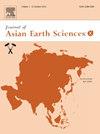Contrasting characteristics observed between the early and late Cretaceous periods: Evidences from geochemical and isotopic studies of clastic rocks from the Tethys Himalaya, India
IF 2.3
Q3 GEOSCIENCES, MULTIDISCIPLINARY
引用次数: 0
Abstract
This study uses a multi-proxy approach on Cretaceous shales (consisting of early Cretaceous Giumal shale and late Cretaceous Chikkim shale of Lagudarsi Group) from the Spiti region of the Indian Tethys Himalaya to assess paleo-weathering, redox conditions, paleoclimate, provenance characteristics and tectonic setting. Geochemical weathering indices such as the Chemical Index of Alteration (CIA), Weathering Index of Parker (WIP) and Ca-free weathering indices (CIX) suggest a shift in weathering intensity from low to high degrees during the Cretaceous period in the source area, also shown in the Al2O3–CaO* + Na2O–K2O (A–CN–K) diagram. Redox-sensitive trace element ratios like V/(V + Ni), V/Sc and Ce anomalies, Total Organic Carbon (TOC), δ13C and δ34S values indicate an anoxic marine depositional environment, documenting an ocean anoxic event (OAE). Provenance discrimination diagrams and geochemical ratios incorporating Nd–Sr isotopes indicate a felsic-dominant source for early Cretaceous Giumal shale and a more mafic-dominant source for late Cretaceous Chikkim shale. Geochemical proxies (Rb/Sr, Mg/Ca, Al/K and CIA) record a shift from humid (non-glacial) climate during the early Cretaceous to cold (glacial) climate during the late Cretaceous. Discriminant diagrams (K2O/Na2O–SiO2, La/Sc–Ti/Zr, and La–Th–Sc) suggest a passive margin tectonic setting for the early Cretaceous, whereas an active continental margin for late Cretaceous shale in the Spiti region. These findings provide insights into the climatic and tectonic evolution of the Indian Tethys Himalaya during the Cretaceous period, contributing to the understanding of global anoxic events and regional sedimentary and tectonic history.

早白垩世和晚白垩世的对比特征:来自印度特提斯-喜马拉雅地区碎屑岩地球化学和同位素研究的证据
以印度特提斯-喜马拉雅山脉斯皮提地区白垩系(Lagudarsi组早白垩世Giumal页岩和晚白垩世Chikkim页岩)为研究对象,采用多代理方法评价了古风化、氧化还原条件、古气候、物源特征和构造背景。化学蚀变指数(CIA)、帕克风化指数(WIP)和无ca风化指数(CIX)等地球化学风化指标表明,白垩纪烃源区风化强度由低向高转变,也体现在Al2O3-CaO * + Na2O-K2O (a- cn - k)图中。V/(V + Ni)、V/Sc和Ce等对氧化还原敏感的微量元素比值异常、总有机碳(TOC)、δ13C和δ34S值表明海洋沉积环境缺氧,记录了海洋缺氧事件(OAE)。含Nd-Sr同位素的物源鉴别图和地球化学比值表明,早白垩世第三系页岩的物源以长质岩为主,晚白垩世奇金页岩的物源以镁质岩为主。地球化学指标Rb/Sr、Mg/Ca、Al/K和CIA记录了早白垩世湿润(非冰期)气候向晚白垩世寒冷(冰期)气候的转变。判别图(K2O/ Na2O-SiO2、La/ Sc-Ti /Zr和La - th - sc)表明Spiti地区早白垩世为被动边缘构造环境,而晚白垩世页岩则为活动大陆边缘构造环境。这些发现有助于了解白垩纪印度特提斯-喜马拉雅地区的气候和构造演化,有助于了解全球缺氧事件和区域沉积和构造历史。
本文章由计算机程序翻译,如有差异,请以英文原文为准。
求助全文
约1分钟内获得全文
求助全文
来源期刊

Journal of Asian Earth Sciences: X
Earth and Planetary Sciences-Earth-Surface Processes
CiteScore
3.40
自引率
0.00%
发文量
53
审稿时长
28 weeks
 求助内容:
求助内容: 应助结果提醒方式:
应助结果提醒方式:


